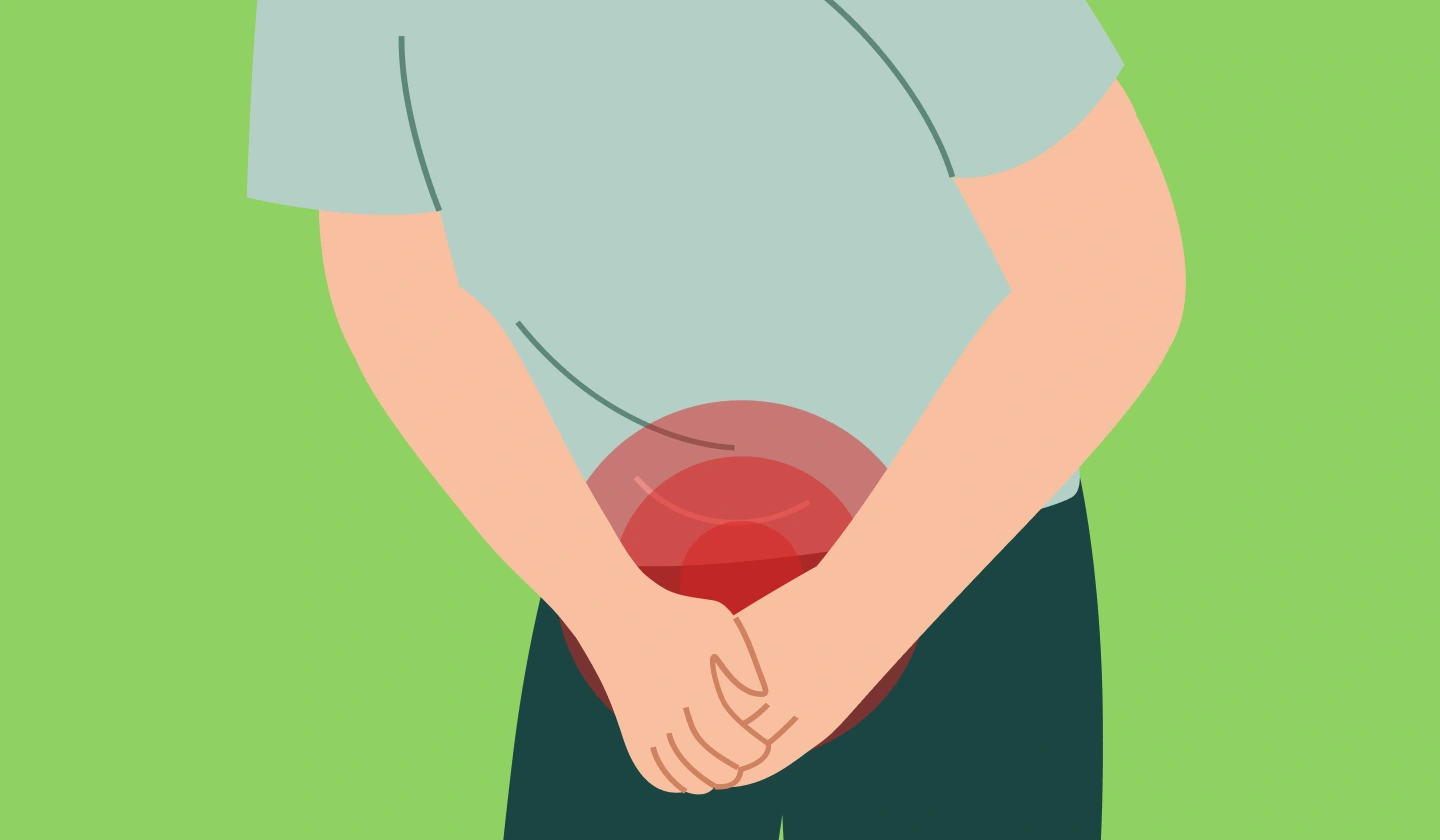
If you’re a man in Glendale dealing with pelvic pain that just won’t subside, difficulty urinating, or ongoing sexual discomfort, you’re certainly not alone. Chronic prostatitis, also referred to as Chronic Prostatitis/Chronic Pelvic Pain Syndrome (CP/CPPS), is a common yet often misunderstood condition that affects men of all ages. It’s estimated that about one in ten men will experience similar symptoms at some point in their lives.
However, what many don’t realize is that nearly 97% of those who experience prostatitis-like pain do not actually have a bacterial or bladder infection. Despite this, antibiotics are still commonly prescribed. In most of these cases, the underlying issue lies in the pelvic floor muscles. Tight, irritated, or uncoordinated muscles in the pelvic floor can easily cause pain and urinary problems that feel identical to prostate inflammation.
For Glendale residents dealing with chronic prostatitis symptoms, pelvic floor physical and occupational therapy offers a research-based solution. At PHRC, our team of expert physical and occupational therapists specialize in identifying and correcting pelvic muscle dysfunction. By reducing tightness, restoring proper movement, and promoting relaxation in the pelvic region, we help men finally address the real source of their discomfort.
What are the Causes of Chronic Pelvic Pain Syndrome in Men?
Chronic Pelvic Pain Syndrome usually does not come from a prostate infection, although many men are initially told that it does. The pain often stems from several other potential sources, most of which involve the interaction of the pelvic floor with other systems in the body.
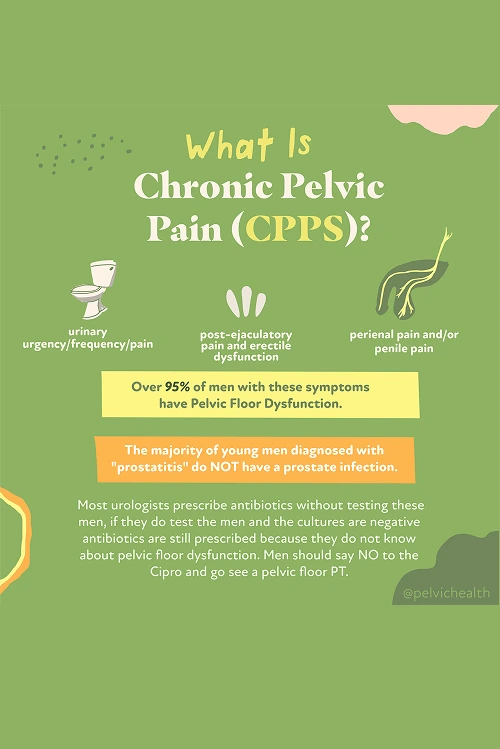
- Lumbar pathology: Nerves serving the pelvic area begin in the lower spine. Conditions like a herniated disc, spinal arthritis, or nerve irritation in the lumbar region can cause pain that radiates forward, producing sensations in the pelvis or prostate, even when the actual source is the spine itself.
- Vascular pathology: Circulation difficulties such as varicoceles, pelvic venous congestion, or disrupted blood flow can result in aching, heaviness, or pressure that feels very similar to prostate discomfort.
- Pelvic floor pathology: The pelvic floor muscles sit beneath the pelvis like a supportive hammock. When these muscles are tight, in spasm, or not coordinating correctly, they can irritate nearby nerves and create pain that feels like it is coming from the prostate or bladder. Often, these muscles are the main contributors to the symptoms.
Other contributing factors can include:
- Past surgeries such as vasectomy or prostate procedures
- Structural issues like hip dysfunction, scoliosis, or leg length differences
- Excessive or sudden changes in exercise
- Long hours of sitting
- Chronic constipation or frequent straining
- Trauma or stress to the pelvic area
While many factors can contribute to chronic pelvic discomfort, most men with these symptoms, whether urinary, sexual, or bowel-related, ultimately have pelvic floor dysfunction driving their pain.
Symptoms of Chronic Pelvic Pain Syndrome Version 2
The signs of CPPS can be difficult to understand because they frequently imitate prostate or bladder disorders, even when the real problem comes from tight or overactive pelvic floor muscles. If you have CPPS, you may notice symptoms like:
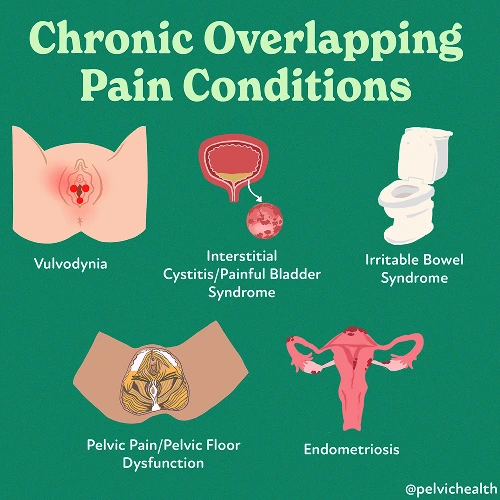
- Aching, pressure, or sharp pain in the perineum, pubic area, or lower abdomen
- Discomfort that feels like it’s coming from the testicles, tip of the penis, or inside the urethra
- Urgency, frequency, weak stream, or the sensation that you can’t fully empty your bladder
- Burning or stinging, even when no infection is present
- Pain with or after ejaculation, erectile discomfort, or reduced sexual satisfaction
- Tightness or aching that overlaps with pelvic discomfort
- A sense of heaviness, pressure, or tight muscles in the pelvic floor area
Associated Diagnoses
Chronic pelvic pain in men often ties back to several established medical causes, spanning from spinal abnormalities to vascular and muscular issues within the pelvic region.
Back-related concerns like lumbar disc herniation, nerve compression, or arthritis can irritate nerves that travel toward the pelvis, creating pain patterns mistaken for prostate problems. Circulatory disorders, including varicocele, pelvic vein congestion, or testicular torsion, can impede normal blood flow and create sensations of throbbing, fullness, or sharp discomfort. Though Chronic Pelvic Pain Syndrome is frequently diagnosed, pelvic floor dysfunction can also overlap with conditions such as pudendal neuralgia, painful bladder syndrome, or hard flaccid syndrome.
In numerous cases, dysfunction of the pelvic floor forms the common thread, either initiating pain itself or intensifying symptoms arising from the back or vascular system.
Diagnostic Challenges
A major source of frustration for men living with CPPS is being misdiagnosed. Many are informed that they have prostatitis and are given rounds of antibiotics even though there is no sign of infection. Research consistently shows that more than 90% of men reporting pelvic or genital pain symptoms do not actually have a bacterial infection in the prostate gland.
Most men actually fit into the National Institutes of Health (NIH) Category III prostatitis group, which includes inflammatory and non-inflammatory CPPS. The NIH identifies five categories:
- Category I: Acute bacterial prostatitis (true infection, sudden and severe)
- Category II: Chronic bacterial prostatitis (chronic infection, often with repeat UTIs)
- Category IIIa: Inflammatory CPPS (white blood cells seen on testing, but no bacteria)
- Category IIIb: Non-inflammatory CPPS (no white blood cells or infection, but symptoms are present)
- Category IV: Asymptomatic inflammatory prostatitis (inflammation without symptoms)
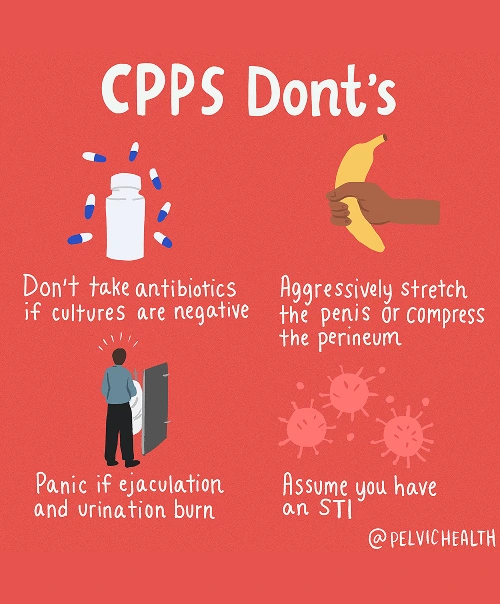
Most men actually fit into the National Institutes of Health (NIH) Category III prostatitis group, which includes inflammatory and non-inflammatory CPPS. The NIH identifies five categories:
- Category I: Acute bacterial prostatitis (true infection, sudden and severe)
- Category II: Chronic bacterial prostatitis (chronic infection, often with repeat UTIs)
- Category IIIa: Inflammatory CPPS (white blood cells seen on testing, but no bacteria)
- Category IIIb: Non-inflammatory CPPS (no white blood cells or infection, but symptoms are present)
- Category IV: Asymptomatic inflammatory prostatitis (inflammation without symptoms)

Since both lumbar and vascular conditions can produce pain that feels almost identical to pelvic floor dysfunction, diagnostic tests often come back showing no abnormalities. This uncertainty leaves men searching for explanations. In many cases, they are prescribed antibiotics or referred from one provider to another, only to find little relief. True progress usually begins once they reach pelvic floor physical and occupational therapy, which focuses directly on the actual root of the discomfort.
Symptoms of Chronic Pelvic Pain Syndrome
Since CPPS typically doesn’t stem from bacterial infection, the treatment plan moves away from antibiotics and instead aims to restore proper muscle balance and calm irritated nerves. The focus is on reestablishing harmony in the pelvic floor and addressing any contributing factors throughout the body.
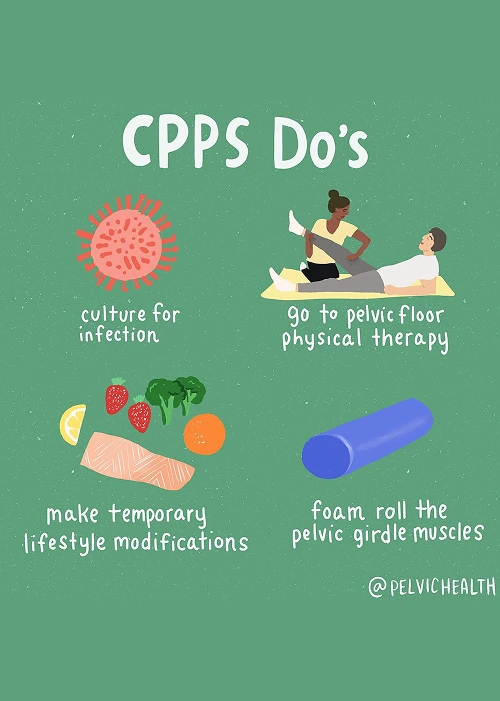
- Pelvic floor physical and occupational therapy: For most men with CPPS, therapy is the core of treatment. By using gentle manual techniques and guided exercise, therapy helps ease tension in the pelvic floor, retrain muscular coordination, and quiet the nerve pathways responsible for pain and urinary symptoms.
- Spine and back treatment: If lower back or spinal issues aggravate the pelvic region, physical and occupational therapy can help by improving posture, mobility, and overall body mechanics. When necessary, a physician may also suggest injections to reduce nerve irritation.
- Vascular-related treatment: For men whose pain involves circulation problems, therapy focuses on improving blood flow and releasing muscle guarding to alleviate pressure on pelvic veins. Breathing techniques and posture work are often part of this process.
- Biomechanical support: Restoring mobility in the hips and pelvis and correcting mechanical imbalances can help distribute pressure evenly, reducing the stress that contributes to chronic discomfort.
- Lifestyle adjustments: Simple daily changes like adjusting how you sit, staying hydrated, preventing constipation, and returning to exercise at a safe pace all help maintain symptom control and reduce recurrence.
How We Can Help with Your Chronic Pelvic Pain
For many men in Glendale living with chronic pelvic pain, the search for answers can feel endless. You may have spent months or even years trying different medications, seeing multiple providers, and still not finding relief. By the time you reach us, you’ve probably been prescribed antibiotics or heard varying explanations for your pain. That’s why a focused, specialized evaluation with one of our pelvic floor physical and occupational therapists at PHRC can be life-changing.
During your evaluation, your PHRC therapist in Glendale will sit down with you to discuss your health history, previous diagnoses, and what treatments you’ve already tried. We’ll explore how your symptoms have affected your daily activities and overall well-being. We know how frustrating and isolating this journey can feel, and we make it a priority to listen and understand every detail of your experience.
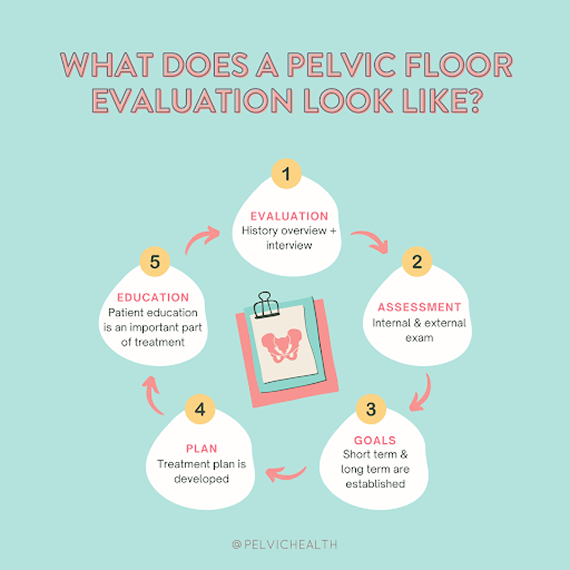
How We Can Help with Your Chronic Pelvic Pain
For many men in Glendale living with chronic pelvic pain, the search for answers can feel endless. You may have spent months or even years trying different medications, seeing multiple providers, and still not finding relief. By the time you reach us, you’ve probably been prescribed antibiotics or heard varying explanations for your pain. That’s why a focused, specialized evaluation with one of our pelvic floor physical and occupational therapists at PHRC can be life-changing.
During your evaluation, your PHRC therapist in Glendale will sit down with you to discuss your health history, previous diagnoses, and what treatments you’ve already tried. We’ll explore how your symptoms have affected your daily activities and overall well-being. We know how frustrating and isolating this journey can feel, and we make it a priority to listen and understand every detail of your experience.
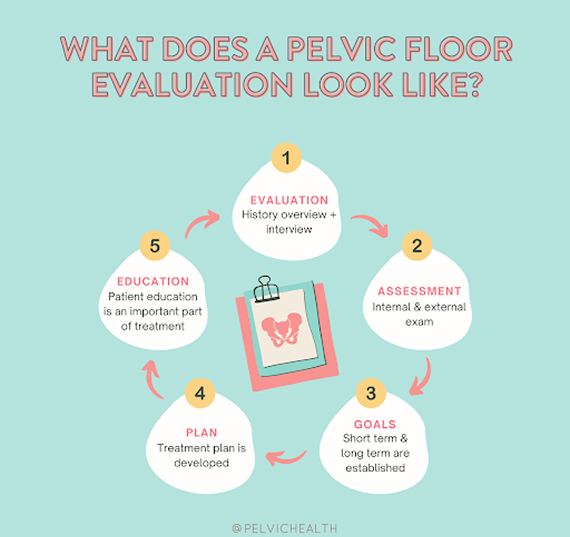
Your physical exam includes an in-depth look at your pelvic floor muscles, connective tissues, joints, nerves, and movement patterns. Once your evaluation is complete, your therapist will review the findings and explain what may be contributing to your pain. You’ll work together to build an individualized plan that includes short- and long-term goals for recovery.
Most men begin with pelvic floor physical and occupational therapy sessions once or twice a week for about twelve weeks. You’ll also receive a customized home program to continue your progress between appointments. Throughout your care, your PHRC therapist will coordinate with your other providers to make sure you have full support. Our team is dedicated to helping you feel comfortable again and finally move beyond your symptoms.
